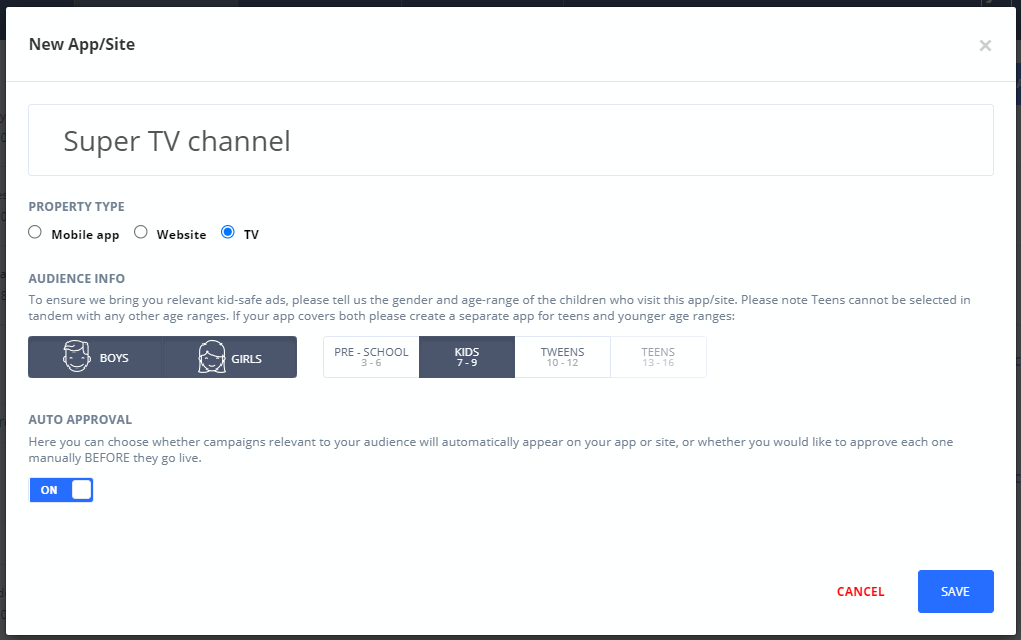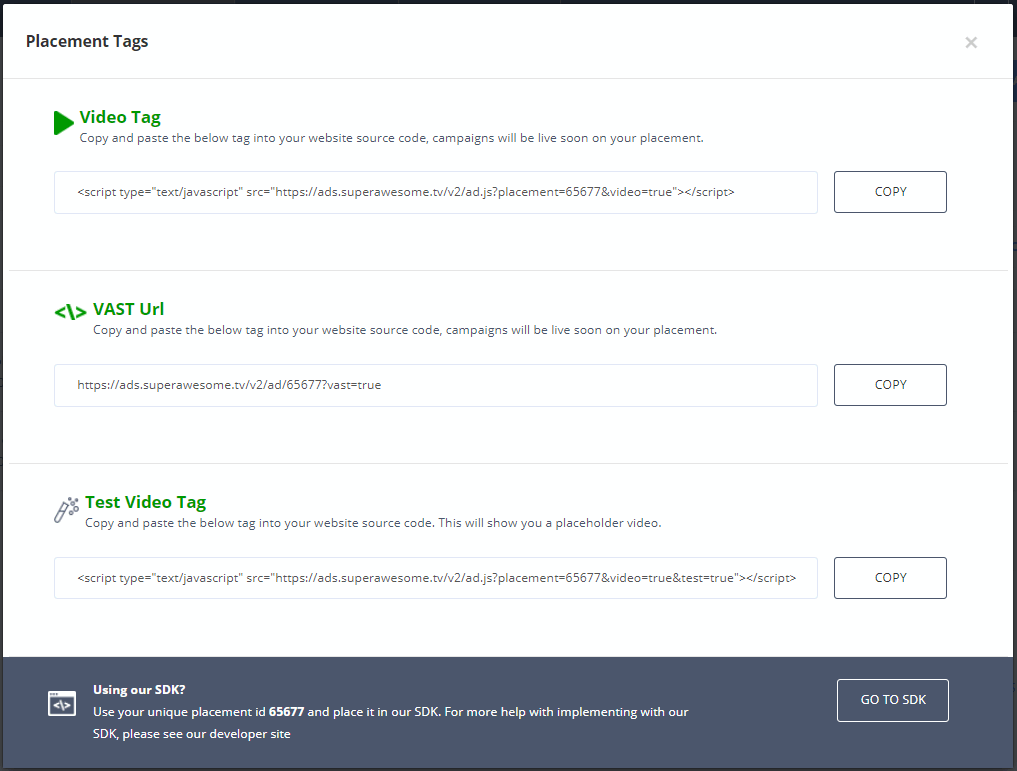To create an ad placement for CTV, you first create the channel/streaming device, then create the placement for that channel/streaming device, and then generate the tags for the placement.
Create a channel/streaming device
You create your channel/streaming device as an ‘App/Site’ in the Apps and Sites tab. We recommend the following guidelines:
- Use a unique placement tag per channel/streaming device to ensure KPI metrics are aligned.
- CTV & OTT can be grouped together as one App/Site.
- If you have multiple channels with different age or gender-related content, ensure an App/Site is created for each of these.
- If you have multiple channels which fall into the same age/gender, you can create one App/Site and then dynamically pass the channel name in the bundle macro.
To create the App/Site:
- Select the Apps and Sites tab, and then click Create a new app/site:
 The New App/Site view is displayed:
The New App/Site view is displayed: 
- Enter the channel/streaming device details:
| Item | Description |
|---|---|
| Name | Give your channel or streaming device a unique, descriptive name. |
| Property type | Select ‘TV’. |
| Audience info | Select the age and demographic that suit your platform best to ensure the most relevant ads appear for your users. – To increase relevance, it is recommended that you select a maximum of two age groups per App/Site . – ‘Teens 13-16’ cannot be selected in conjunction with any other age group. Because our advertising is contextually targeted, we require high levels of accuracy when selecting your age buckets. If you are unsure of your age demographic, try getting a young person’s opinion. If you cannot decide, reach out to your Account Manager. |
| Auto approval | This setting determines whether all ads are approved by default or if you’d like to approve every ad that runs. – If set to ‘On’, you automatically accept all contextually relevant ads from our adserver. Auto-approval is recommended, for scalability. – If set to ‘Off’, you will need to dedicate resources to manually approve each creative before they go live. This will impact your fill rates and is not the optimal setup. |
- Click Save. The view closes, and the new channel/streaming device appears in the Apps and Sites view.
Create a placement
Next, create your ad placement on your channel/streaming device:
- In the Apps and sites view, hover over the channel/streaming device and click Add a new placement:

- In the New Placement view, select ‘Video formats’ from the dropdown menu, and then select either ‘Video’ or ‘TV Video’:

- Enter a name for your placement. Choose a unique and descriptive name, so you can easily identify the placement in the dashboard and reports.
- Click Save. The New Placement view closes.
- In the Apps and Sites view, expand the channel/streaming device to view the details of the new placement:

The placement details are as follows:
| Item | Description |
|---|---|
| Dimensions | The format and size of the displayed ad. |
| Placement name | The name you provided for the placement. |
| Placement ID | A unique placement ID. This can be used to report on placement level performance. Placement performance reporting is great for campaign optimisation and troubleshooting |
| Linked ads | The number of live ads that have been linked to the placement. This is zero until your placement goes live. When you first create your tag, there will be no ads linked. As soon as you begin to send requests, this number should reflect the number of suitable ads for this placement. |
| Get placement tags | Click to generate the placement tags for the placement. |
| <Settings> | Click to: – Provide the URL and an image for the creative you wish to use as a fallback. – Provide a fallback tag. – View the impression / click counter. – Preview a mock-up of the ad as it will appear on a mobile device. – Edit the details of the placement. – Delete the placement. |
Get the placement tags
- In the Apps and Sites view, expand the channel/streaming device to view the new placement.
- Hover over the placement and then click Get placement tags:
 The Placement Tags view displays the auto-generated tags. Each tag contains the unique placement ID:
The Placement Tags view displays the auto-generated tags. Each tag contains the unique placement ID: 
- Copy the Video Tag or VAST URL, as required.
Add VAST tag macros
To capture additional data, add the following macros at the end of each placement’s unique VAST tag:
| To capture this… | … add this macro | Format |
|---|---|---|
| Channel data | Bundle | &bundle=[insert bundle here] |
| The name of the show (series) or movie | Show Title | &show=[insert series or movie title here] |
| The genre data | Genre | &genre=[insert genre here] |
Example tag structure
https://ads.superawesome.tv/v2/ad/XXXXX?vast=true&bundle=[insert bundle here]&show=[insert title here]&genre=[insert genre here]
Create an ad pod
Ad podding provides the ability to return multiple ads from a single ad request. This creates an additional opportunity to boost fill rate and monetisation in each ad break, while avoiding duplication.
To set up an ad pod, include these parameters in your VAST tags:
| Parameter | Description | Example format |
|---|---|---|
| &podAdSlots | The maximum number of ads that will be returned in the response. Mandatory if a pod is required. | &podAdSlots=3 |
| &podMaxDuration | The maximum total timeframe (in seconds) of all ads returned. Optional. Can be used only if podAdSlots is also present in the tag. | &podMaxDuration=20 |
